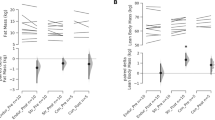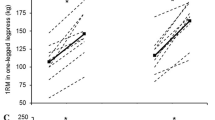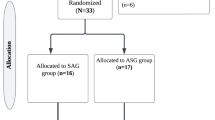Abstract
In this study adaptations in body composition, physical fitness and metabolic health were examined during 21 weeks of endurance and/or strength training in 39- to 64-year-old healthy women. Subjects (n = 62) were randomized into endurance training (E), strength training (S), combined strength and endurance training (SE), or control groups (C). S and E trained 2 and SE 2 + 2 times in a week. Muscle strength and maximal oxygen uptake (VO2max) were measured. Leg extension strength increased 9 ± 8% in S (P < 0.001), 12 ± 8% in SE (P < 0.001) and 3 ± 4% in E (P = 0.036), and isometric bench press 20% only in both S and SE (P < 0.001). VO2max increased 23 ± 18% in E and 16 ± 12% in SE (both P < 0.001). The changes in the total body fat (dual X-ray absorptiometry) did not differ between groups, but significant decreases were observed in E (−5.9%, P = 0.022) and SE (−4.8%, P = 0.005). Lean mass of the legs increased 2.2–2.9% (P = 0.004–0.010) in S, SE and E. There were no differences between the groups in the changes in blood lipids, blood pressure or serum glucose and insulin. Total cholesterol and low-density lipoprotein cholesterol decreased and high-density lipoprotein cholesterol increased in E. Both S and SE showed small decreases in serum fasting insulin. Both endurance and strength training and their combination led to expected training-specific improvements in physical fitness, without interference in fitness or muscle mass development. All training methods led to increases in lean body mass, but decreases in body fat and modest improvements in metabolic risk factors were more evident with aerobic training than strength training.




Similar content being viewed by others
References
American College of Sports Medicine (2002) Position stand: progression models in resistance training for healthy adults. Med Sci Sports Exerc 34:364–380. doi:10.1097/00005768-200202000-00027
Asikainen TM, Kukkonen-Harjula K, Miilunpalo S (2004) Exercise for health for early postmenopausal women: a systematic review of randomised controlled trials. Sports Med 34:753–778. doi:10.2165/00007256-200434110-00004
Aunola S, Rusko H (1986) Aerobic and anaerobic thresholds determined from venous lactate or from ventilation and gas exchange in relation to muscle fiber composition. Int J Sports Med 7:161–166. doi:10.1055/s-2008-1025755
Boardley D, Fahlman M, Topp R, Morgan AL, McNevin N (2007) The impact of exercise training on blood lipids in older adults. Am J Geriatr Cardiol 16:30–35. doi:10.1111/j.1076-7460.2007.05353.x
Braith RW, Stewart KJ (2006) Resistance exercise training: its role in the prevention of cardiovascular disease. Circulation 113:2642–2650. doi:10.1161/CIRCULATIONAHA.105.584060
Chilibeck PD, Calder AW, Sale DG, Webber CE (1998) A comparison of strength and muscle mass increases during resistance training in young women. Eur J Appl Physiol 77:170–175. doi:10.1007/s004210050316
Elliott KJ, Sale C, Cable NT (2002) Effects of resistance training and detraining on muscle strength and blood lipid profiles in postmenopausal women. Br J Sports Med 36:340–344. doi:10.1136/bjsm.36.5.340
Fahlman MM, Boardley D, Lambert CP, Flynn MG (2002) Effects of endurance training and resistance training on plasma lipoprotein profiles in elderly women. J Gerontol A Biol Sci Med Sci 57:B54–B60
Ferketich AK, Kirby TE, Alway SE (1998) Cardiovascular and muscular adaptations to combined endurance and strength training in elderly women. Acta Physiol Scand 164:259–267. doi:10.1046/j.1365-201X.1998.00428.x miscellaneous article
Friedewald WT, Levy RI, Fredrickson DS (1972) Estimation of the concentration of low-density lipoprotein cholesterol in plasma, without use of the preparative ultracentrifuge. Clin Chem 18:499–502
Hagberg JM, Graves JE, Limacher M et al (1989) Cardiovascular responses of 70- to 79-year-old men and women to exercise training. J Appl Physiol 66:2589–2594. doi:10.1063/1.344224
Häkkinen K, Kallinen M, Izquierdo M et al (1998a) Changes in agonist-antagonist EMG, muscle CSA, and force during strength training in middle-aged and older people. J Appl Physiol 84:1341–1349. doi:10.1007/BFb0103417
Häkkinen K, Pakarinen A, Newton RU, Kraemer WJ (1998b) Acute hormone responses to heavy resistance lower and upper extremity exercise in young versus old men. Eur J Appl Physiol 77:312–319. doi:10.1007/s004210050339
Häkkinen K, Pakarinen A, Kraemer WJ, Newton RU, Alen M (2000) Basal concentrations and acute responses of serum hormones and strength development during heavy resistance training in middle-aged and elderly men and women. J Gerontol A Biol Sci Med Sci 55:B95–B105
Häkkinen K, Pakarinen A, Kraemer WJ, Häkkinen A, Valkeinen H, Alen M (2001) Selective muscle hypertrophy, changes in EMG and force, and serum hormones during strength training in older women. J Appl Physiol 91:569–580. doi:10.1007/3-540-44991-4
Häkkinen K, Alen M, Kraemer WJ et al (2003) Neuromuscular adaptations during concurrent strength and endurance training versus strength training. Eur J Appl Physiol 89:42–52. doi:10.1007/s00421-002-0751-9
Häkkinen A, Holopainen E, Kautiainen H, Sillanpää E, Häkkinen K (2006) Neuromuscular function and balance of prepubertal and pubertal blind and sighted boys. Acta Paediatr 95:1277–1283. doi:10.1080/08035250600573144
Hawley JA, Lessard SJ (2008) Exercise training-induced improvements in insulin action. Acta Physiol (Oxf) 192:127–135. doi:10.1007/978-3-540-74921-9
Hickson RC (1980) Interference of strength development by simultaneously training for strength and endurance. Eur J Appl Physiol 45:255–263. doi:10.1007/BF00421333
Holten MK, Zacho M, Gaster M, Juel C, Wojtaszewski JF, Dela F (2004) Strength training increases insulin-mediated glucose uptake, GLUT4 content, and insulin signaling in skeletal muscle in patients with type 2 diabetes. Diabetes 53:294–305. doi:10.2337/diabetes.53.2.294
Houtkooper LB, Going SB, Sproul J, Blew RM, Lohman TG (2000) Comparison of methods for assessing body-composition changes over 1 year in postmenopausal women. Am J Clin Nutr 72:401–406
Izquierdo M, Ibanez J, Häkkinen K, Kraemer WJ, Larrion JL, Gorostiaga EM (2004) Once weekly combined resistance and cardiovascular training in healthy older men. Med Sci Sports Exerc 36:435–443. doi:10.1249/01.MSS.0000117897.55226.9A
Izquierdo M, Häkkinen K, Ibanez J, Kraemer WJ, Gorostiaga EM (2005) Effects of combined resistance and cardiovascular training on strength, power, muscle cross-sectional area, and endurance markers in middle-aged men. Eur J Appl Physiol 94:70–75. doi:10.1007/s00421-004-1280-5
Jurca R, Lamonte MJ, Barlow CE, Kampert JB, Church TS, Blair SN (2005) Association of muscular strength with incidence of metabolic syndrome in men. Med Sci Sports Exerc 37:1849–1855. doi:10.1249/01.mss.0000175865.17614.74
Kelley GA, Kelley KS (2000) Progressive resistance exercise and resting blood pressure: a meta-analysis of randomized controlled trials. Hypertension 35:838–843. doi:10.1385/159259008X
Kelley GA, Kelley KA, Tran ZV (2001) Aerobic exercise and resting blood pressure: a meta-analytic review of randomized, controlled trials. Prev Cardiol 4:73–80. doi:10.1111/j.1520-037X.2001.00529.x
Kim J, Wang Z, Heymsfield SB, Baumgartner RN, Gallagher D (2002) Total-body skeletal muscle mass: estimation by a new dual-energy X-ray absorptiometry method. Am J Clin Nutr 76:378–383
Kim J, Heshka S, Gallagher D et al (2004) Intermuscular adipose tissue-free skeletal muscle mass: estimation by dual-energy X-ray absorptiometry in adults. J Appl Physiol 97:655–660. doi:10.1152/japplphysiol.00260.2004
Kotani K, Tokunaga K, Fujioka S et al (1994) Sexual dimorphism of age-related changes in whole-body fat distribution in the obese. Int J Obes Relat Metab Disord 18:207–212
Kraemer WJ, Patton JF, Gordon SE et al (1995) Compatibility of high-intensity strength and endurance training on hormonal and skeletal muscle adaptations. J Appl Physiol 78:976–989
Kraemer WJ, Nindl BC, Ratamess NA et al (2004) Changes in muscle hypertrophy in women with periodized resistance training. Med Sci Sports Exerc 36:697–708. doi:10.1249/01.MSS.0000122734.25411.CF
Laaksonen DE, Lakka H, Salonen JT, Niskanen LK, Rauramaa R, Lakka TA (2002) Low levels of leisure-time physical activity and cardiorespiratory fitness predict development of the metabolic syndrome. Diabetes Care 25:1612–1618. doi:10.2337/diacare.25.9.1612
Laaksonen DE, Niskanen L, Lakka HM, Lakka TA, Uusitupa M (2004) Epidemiology and treatment of the metabolic syndrome. Ann Med 36:332–346. doi:10.1080/07853890410031849
Lakka TA, Laaksonen DE (2007) Physical activity in prevention and treatment of the metabolic syndrome. Appl Physiol Nutr Metab 32:76–88. doi:10.1139/H06-113
Leon AS, Sanchez OA (2001) Response of blood lipids to exercise training alone or combined with dietary intervention. Med Sci Sports Exerc 33:S502–S515. doi:10.1097/00005768-200106001-00021 discussion S528–S529
McCarthy JP, Pozniak M, Agre JC (2002) Neuromuscular adaptations to concurrent strength and endurance training. Med Sci Sports Exerc 34:511–519. doi:10.1097/00005768-200203000-00019
Nindl BC, Harman EA, Marx JO et al (2000) Regional body composition changes in women after 6 months of periodized physical training. J Appl Physiol 88:2251–2259
Pascot A, Lemieux S, Lemieux I et al (1999) Age-related increase in visceral adipose tissue and body fat and the metabolic risk profile of premenopausal women. Diabetes Care 22:1471–1478. doi:10.2337/diacare.22.9.1471
Pritchard JE, Nowson CA, Strauss BJ, Carlson JS, Kaymakci B, Wark JD (1993) Evaluation of dual energy X-ray absorptiometry as a method of measurement of body fat. Eur J Clin Nutr 47:216–228
Rockl KS, Witczak CA, Goodyear LJ (2008) Signaling mechanisms in skeletal muscle: acute responses and chronic adaptations to exercise. IUBMB Life 60:145–153. doi:10.1002/iub.21
Sallinen J, Pakarinen A, Fogelholm M et al (2006) Serum basal hormone concentrations and muscle mass in aging women: effects of strength training and diet. Int J Sport Nutr Exerc Metab 16:316–331
Seip RL, Moulin P, Cocke T et al (1993) Exercise training decreases plasma cholesteryl ester transfer protein. Arterioscler Thromb 13:1359–1367
Shen W, Punyanitya M, Chen J et al (2006) Waist circumference correlates with metabolic syndrome indicators better than percentage fat. Obesity (Silver Spring) 14:727–736. doi:10.1038/oby.2006.83
Sillanpää E, Häkkinen A, Nyman K et al (2008) Body composition and fitness during strength and/or endurance training in older men. Med Sci Sports Exerc 40:950–958
Sipilä S, Suominen H (1995) Effects of strength and endurance training on thigh and leg muscle mass and composition in elderly women. J Appl Physiol 78:334–340
Stefanick ML, Mackey S, Sheehan M, Ellsworth N, Haskell WL, Wood PD (1998) Effects of diet and exercise in men and postmenopausal women with low levels of HDL cholesterol and high levels of LDL cholesterol. N Engl J Med 339:12–20. doi:10.1056/NEJM199807023390103
Tracy BL, Ivey FM, Hurlbut D et al (1999) Muscle quality. II. Effects of strength training in 65- to 75-year-old men and women. J Appl Physiol 86:195–201
Tsuzuku S, Kajioka T, Endo H, Abbott RD, Curb JD, Yano K (2007) Favorable effects of non-instrumental resistance training on fat distribution and metabolic profiles in healthy elderly people. Eur J Appl Physiol 99:549–555. doi:10.1007/s00421-006-0377-4
Vasankari TJ, Kujala UM, Vasankari TM, Ahotupa M (1998) Reduced oxidized LDL levels after a 10-month exercise program. Med Sci Sports Exerc 30:1496–1501. doi:10.1097/00005768-199810000-00005
Vincent KR, Braith RW, Bottiglieri T, Vincent HK, Lowenthal DT (2003) Homocysteine and lipoprotein levels following resistance training in older adults. Prev Cardiol 6:197–203. doi:10.1111/j.1520-037X.2003.01723.x
Wannamethee SG, Shaper AG, Lennon L, Whincup PH (2007) Decreased muscle mass and increased central adiposity are independently related to mortality in older men. Am J Clin Nutr 86:1339–1346
Acknowledgments
This study was partly supported by a grant from the Ministry of Education, Finland and the Central Finland Health Care District, Jyväskylä Finland.
Author information
Authors and Affiliations
Corresponding author
Rights and permissions
About this article
Cite this article
Sillanpää, E., Laaksonen, D.E., Häkkinen, A. et al. Body composition, fitness, and metabolic health during strength and endurance training and their combination in middle-aged and older women. Eur J Appl Physiol 106, 285–296 (2009). https://doi.org/10.1007/s00421-009-1013-x
Accepted:
Published:
Issue Date:
DOI: https://doi.org/10.1007/s00421-009-1013-x




